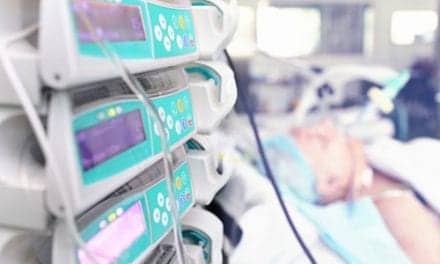Protecting healthcare workers from tuberculosis.
By Naomi Bock, MD
What do the following cases have in common?
- Case 1: A 65-year-old male with a 50- pack-year smoking history has a right-upper lobe mass found on chest radiography done as part of a work-up of weight loss. He undergoes bronchoscopy with transbronchial biopsy of his presumed lung cancer.
- Case 2: A 32-year-old female with human immunodeficiency virus (HIV) infection is admitted with fever and dyspnea and has bilateral diffuse interstitial infiltrates on chest radiography. She is unable to produce a sputum specimen for silver staining and undergoes sputum induction.
- Case 3: A 50-year-old male known to the emergency department personnel for receiving frequent evaluations before admission to alcohol detoxification programs is brought in semi-comatose by medics. He is found to be hypoxic and in respiratory failure, with a right middle lobe infiltrate on chest radiography. He is intubated and transferred to the intensive care unit for treatment of aspiration pneumonia.
- Case 4: A 47-year-old female who has been treated for pulmonary tuberculosis for 6 weeks through the county health department is admitted to the gastro- intestinal service with jaundice, nausea, vomiting, and right upper quadrant tenderness. The diagnosis is hepatitis due to her antituberculosis chemotherapy.
Answer: The diagnosis of potentially infectious pulmonary tuberculosis was missed; all four cases were sources of nosocomial spread of Mycobacterium tuberculosis.
In Case 1, bronchoscopy personnel did not suspect tuberculosis and did not wear masks during the procedure. In Case 2, the sputum induction booth was not exhausting correctly. In Case 3, the diagnosis was not suspected and the patient was not placed in respiratory isolation. In Case 4, although the patient had been on antituberculosis chemotherapy for 6 weeks, her isolates were drug-resistant and her sputum-smear was still positive for acid-fast bacilli when she was admitted to the gastrointestinal service.
Background
Healthcare workers have always been at increased risk for tuberculosis infection and disease, compared with the general community. In 1930 Steidl observed, “Tuberculosis might be called an industrial hazard for the medical profession. It is not unusual to find that 10 percent of a class develop clinical tuberculosis within a year or two of their graduation.”1 In a landmark series of studies from Oslo, Norway, in the 1920s, Heimbeck showed the risk to student nurses with negative tuberculin skin tests, when the skin tests of 210 of 220 (95 percent) converted by graduation, and 48 cases of tuberculosis disease occurred in the group.2 Similar reports of increased rates of tuberculin conversion and incidence of tuberculosis disease came from other nursing schools, sanatoria, and medical facilities.3-8
The first hospital tuberculosis infection control plan was recommended by Myers in 1930 to perform tuberculin testing and chest radiography on all new employees; do follow-up tuberculin testing and chest radiography every 6 to 12 months; exclude tuberculosis in all new patients admitted to the hospital, including initiating routine admission chest radiography; establish a tuberculosis service in all hospitals; and practice aseptic technique as was routine for other infections.9 Over the next few decades, as these or similar controls were adopted, the number of tuberculosis cases among health care workers declined.10
With the introduction of highly effective chemotherapy for tuberculosis disease in the 1950s, US case rates fell dramatically and the risk of occupational infection and subsequent disease in health care workers declined further. Infection control practices became lax but, regardless, few nosocomial tuberculosis outbreaks were reported over the next three decades.11-12 The resurgence of tuberculosis in the mid-1980s hit hospitals hard. Inpatients in particular, but health care workers also, were involved in outbreaks of tuberculosis due to nosocomial transmission of M. tuberculosis, often amplified because HIV-infected patients with new tuberculosis infection progressed rapidly to active disease.13-18 When the outbreaks involved multidrug-resistant tuberculosis, case mortality rates approached those of the preantibiotic era.19 Tuberculosis among health care workers can be prevented, however, with appropriate infection control practices.
Transmission of M. Tuberculosis
Multiple factors influence the transmission of M. tuberculosis from a person with pulmonary or laryngeal tuberculosis (the source-case) to a health care worker or anyone else exposed to the source-case (the contact), including source-case factors, environmental factors, and circumstances of the exposure. M. tuberculosis is transmitted by airborne contagion.20 Tuberculosis infection is acquired by inhalation of a tubercle bacillus, which is contained in an aerosolized particle small enough (1 to 5 microns) to reach an alveolus.20
Coughing generates aerosols, as do forced expiratory maneuvers and other procedures such as spirometry, bronchoscopy, or sputum induction. These procedures are frequently done in the hospital and can be important source-case factors influencing nosocomial transmission. Another source-case factor is the concentration of bacilli in the lungs: patients with cavitary lesions on chest radiography, which represent a concentration of 10 million to 1 billion bacilli per milliliter of sputum, are most contagious. Patients with organisms identified on acid-fast stained sputum smears have on average 5,000 to 10,000 bacilli per milliliter of sputum; these “smear-positive” patients are more contagious than “smear-negative” patients.21, 22
The third significant factor influencing source-case infectiousness is the initiation of chemotherapy. Chemotherapy decreases the bacillary population in the lung and reduces coughing. Transmission appears to cease very soon after effective chemotherapy has begun,23 though this occurs less rapidly in patients with advanced cavitary disease who continue to cough. Patients with unsuspected drug-resistant M. tuberculosis may not receive effective chemotherapy until susceptibility testing results are available many weeks after they start treatment.
Environmental factors that influence transmission are the pattern and volume of air recirculation and the effects of ultraviolet light. Early studies showed that in normal indoor environmental conditions, approximately 60 percent of aerosolized M. tuberculosis survived for 3 hours, approximately 50 percent for 6 hours, and approximately 30 percent were still wafting in the air after 9 hours.24 Environmental controls of potentially contaminated air circulation in hospitals are thus very important in preventing nosocomial transmission. Exposure to ultraviolet light kills mycobacteria.25
The key factors related to the circumstances of exposure are intensity and duration. Transmission of M. tuberculosis is not very efficient; generally, weeks or months of close contact are required. Thus, household contacts of a source-case are most at risk; in the hospital setting, most outbreaks have involved inpatient to inpatient or inpatient to health care worker transmission.13-18, 26 Transient exposure in an outpatient setting has not been shown to result in transmission to exposed outpatients.27
Preventing Nosocomial Transmission of M. Tuberculosis
The key to an effective tuberculosis infection control program is early detection, isolation, and effective treatment of persons with active disease.28 A hierarchy of infection control measures has been recommended by the Centers for Disease Control and Prevention (CDC), and other organizations, to prevent nosocomial transmission of tuberculosis.28-30 In order of importance, these include: administrative controls, engineering controls, and personal respiratory protective equipment, ie, masks. Similarly, the Occupational Safety and Health Administration (OSHA) has mandatory requirements for health care facilities in the United States.31 In late 1997, OSHA published in draft form a proposed TB Standard, which should be finalized by 1999.32
Each institution should establish an infection control program appropriate for its patient population. Within an institution, a specific person or group of persons should have the responsibility and authority to develop, implement, and evaluate an infection control plan. The person or group will require expertise in infection control, hospital epidemiology, employee health issues, and engineering.33 CDC guidelines suggest that each institution conduct a risk assessment to help formulate what measures should be implemented and to determine the frequency of review of the program.28 The risk assessment is based on the profile of tuberculosis cases in the community and those cared for within the institution, and classification ranges from minimal risk to high risk, with different recommendations for institutions with varying levels of risk.
Administrative controls, which include measures to reduce the risk of exposure to persons with infectious tuberculosis, as well as surveillance, are the most important component of an infection control program.34 Measures to reduce the risk of exposure ensure that patients are screened carefully for tuberculosis, that those suspected of having tuberculosis are isolated upon admission to the hospital, that a diagnosis is made promptly, and that appropriate antituberculosis chemotherapy is initiated.35 In one high-risk hospital, exposure episodes were reduced dramatically by requiring respiratory isolation for all patients admitted with tuberculosis in the differential diagnosis, those from whom respiratory specimens were obtained for acid-fast bacilli smear and culture, those with known active pulmonary tuberculosis, and all HIV-infected patients with an abnormal chest radiograph.34 Patients admitted to respiratory isolation should remain in isolation while they are hospitalized unless infectious tuberculosis has been ruled out by three consecutive acid-fast bacilli smear-negative examinations of respiratory specimens. To facilitate turnover of patients in respiratory isolation, respiratory therapists can induce sputum in patients who have not been able to produce a specimen in the first 24 hours of hospitalization. Patients should remain in the sputum induction booth until coughing induced by the procedure has subsided.
Surveillance is done to detect unsuspected nosocomial transmission of M. tuberculosis, and involves comprehensive and mandatory periodic tuberculin skin testing of all health care workers. Testing should be done at the time of initial employment and at least annually for those health care workers who are not documented to be previously tuberculin skin test positive. Testing may be more frequent, ie, every 6 months, in high incidence areas or if there is evidence of ongoing nosocomial transmission.28 Surveillance is essential for the institution, to evaluate the efficacy of its infection control policy, and for the health care workers so that treatment for tuberculosis infection is offered to those who have a positive tuberculin skin test.
The Mantoux method is recommended for tuberculin skin testing.36 For new employees, two-step testing (a second tuberculin test is performed 1 to 3 weeks after the initial test if it is negative) is recommended for all health care workers who have not had a documented tuberculin skin test in the preceding year. Two-step testing is used to reduce the likelihood that a boosted reaction actually resulting from a distant infection will be misinterpreted as a recent infection and subsequent skin test conversion.37 Along with tuberculin skin test surveillance, health care workers should receive ongoing tuberculosis-related education.
The second level of controls involves engineering controls that reduce or eliminate tuberculosis aerosols in the air.28 These include direct-source control using local exhaust ventilation, in respiratory isolation rooms and sputum induction booths; controlling the direction of airflow to prevent contamination of adjacent areas, ie, negative pressure in isolation rooms, so that air flows from the hall or adjacent areas into the isolation room; dilution and removal of contaminated air by general ventilation, with a minimum of six air exchanges per hour for existing isolation rooms and 12 air exchanges per hour for new construction or renovation; air filtration with high-efficiency particulate air (HEPA) filters when direct exhaust of isolation room air to the outside is not possible; and possibly air disinfection with ultraviolet germicidal irradiation in large waiting areas where ventilation may not be adequate and patients with undiagnosed tuberculosis may be present.
Personal respiratory protection is the last step in the hierarchy of controls. Personal respiratory protective devices or masks should be worn in areas where the risk of exposure to M. tuberculosis aerosols is higher than normal, despite proper implementation of other controls. These areas include respiratory isolation rooms and bronchoscopy suites. The minimum level of respiratory protection mandated by OSHA is the National Institute for Occupational Safety and Health certified N-95 respirator, which has the ability to filter >95 percent of 0.3-mm particles.38 OSHA requires a respiratory protection program that includes medical evaluation, training, and individual fit testing for masks.
Conclusion
Tuberculosis remains an occupational risk for healthcare providers, although the risk varies among and within institutions. Every hospital needs a tuberculosis infection control policy, geared to the level of risk for that particular institution. CDC, OSHA, and others have published guidelines, which can assist designated persons in developing and implementing an appropriate policy.
RT
Naomi Bock, MD, is the assistant professor of medicine at Emory University School of Medicine, Atlanta.
References
- Steidl J. Tuberculosis among students. Bull Harvard Med School Alum Assoc. 1930;5:10-2.
- Heimbeck J. Immunity to tuberculosis. Arch Intern Med. 1928;41:336-42.
- Whitney JS. Tuberculosis among young women. Am J Nurs. 1928;28:766-8.
- Mariette ES. The tuberculosis problem among nurses in a tuberculosis sanatorium. Tubercle. 1936;36:103-25.
- Alarcon DG. Tuberculosis among sanatorium personnel. Dis Chest. 1946;336-42.
- Riggins HM. Tuberculosis control in hospital personnel: a review. Am Rev Tuberc. 1953;67;74-84.
- Reid AC. Control of tuberculosis in employees. J Ind Hyg Toxicol. 1940;22:408-15.
- Macklin MR. Tuberculosis in hospital workers: a summary of Canadian data. Tubercle. 1938;19:193-8.
- Myers JA. The prevention of tuberculosis among nurses. Am J Nurs. 1930;30:1361-72.
- Weis W. TB in student nurses at Philadelphia General Hospital. Am Rev Respir Dis. 1973;107:106-9.
- Lincoln EM. Epidemic of tuberculosis. Adv Tuberc Res. 1965;14:157-201.
- Alpert ME, Levison ME. An epidemic of tuberculosis in medical school. N Engl J Med. 1965;272:718-21.
- Nosocomial transmission of multidrug-resistant tuberculosis among HIV-infected persons. Florida and New York. 1988-1991. MMWR Morb Mortal Wkly Rep. 1991;40:585-91.
- Coronado VG, Beck-Sague CM, Hutton MD, et al. Transmission of multidrug-resistant Mycobacterium tuberculosis among persons with human immunodeficiency virus infection in an urban hospital: epidemiologic and restriction fragment length polymorphism analysis. J Infect Dis. 1993;168:1052-5.
- Pearson ML, Jereb JA, Frieden TR, et al. Nosocomial transmission of multidrug-resistant Mycobacterium tuberculosis: a risk to patients and health care workers. Ann Intern Med. 1992;117:191-6.
- Beck-Sague C, Dooley SW, Hutton MD, et al. Hospital outbreak of multidrug-resistant Mycobacterium tuberculosis infections: factors in transmission to staff and HIV-infected patients. JAMA. 1992;268:1280-6.
- Edlin BR, Tokars JI, Grieco MH, et al. An outbreak of multidrug-resistant tuberculosis among hospitalized patients with the acquired immunodeficiency syndrome. N Engl J Med. 1992;326:1514-21.
- Jarvis WR. Nosocomial transmission of multidrug-resistant Mycobacterium tuberculosis. Res Microbiol. 1993;144:117-22.
- Valway S, Pearson ML, Ikeda R, Edlin BR. HIV-infected health care workers with multidrug-resistant tuberculosis (MDR-TB), 1990-2 [abstract]. In: Program and abstracts of the 33rd Interscience Conference on Antimicrobial Agents and Chemotherapy, October 17-20, 1993; New Orleans. Washington, DC: American Society for Microbiology, 1993:231.
- Wells WF. Airborne Contagion and Air Hygiene. Cambridge, Mass: Harvard University Press; 1955.
- Grzybowski S, Barnett GD, Styblo K. Contacts of cases of active pulmonary tuberculosis. Bull Int Union Against Tuberc. 1975;60:90.
- Rouillon A, Perdrizet S, Parrot R. Transmission of tubercle bacilli: the effects of chemotherapy. Tubercle. 1976;57:276.
- Brooks SM, Lassiter NL, Young EC. A pilot study concerning the infection risk of sputum positive tuberculosis patients on chemotherapy. Am Rev Resp Dis. 1973;109:323.
- Loudon RG, Roberts RM. Droplet expulsion from the respiratory tract. Am Rev Resp Dis. 1967;99:109.
- Riley RL, Permutt S. Room air disinfection by ultraviolet irradiation of upper air. Arch Environ Health. 1971;22:208.
- Zaza S, Blumberg HM, Beck Sague C, et al. Nosocomial transmission of Mycobacterium tuberculosis: role of health care workers in outbreak propagation. J Infect Dis. 1995;172:1542-9.
- Bock NN, Sotir MJ, Parrott P, Blumberg HM. Nosocomial tuberculosis exposure in an outpatient setting–evaluation of patients exposed to health care providers with tuberculosis. Infect Control Hosp Epidemiol. In Press 1999.
- Centers for Disease Control and Prevention. Guidelines for preventing the transmission of Mycobacterium tuberculosis in health care settings, 1994. MMWR Morb Mortal Wkly Rep. 1994;43(RR-13):1-13.
- American Hospital Association Technical Panel on Infections. Tuberculosis Control in the Hospital–A Special Briefing. Chicago, Ill: American Hospital Association; 1994.
- Anonymous. Control and prevention of tuberculosis in the United Kingdom: Code of Practice 1994. Joint Tuberculosis Committee of the British Thoracic Society. Thorax. 1994;49:1193-1200.
- Occupational Safety and Health Administration. Enforcement Procedures and Scheduling for Occupational Exposure to Tuberculosis. OSHA Instruction (CPL 2.106). February 9, 1996.
- Occupational Safety and Health Adminstration. Occupational exposure to tuberculosis. Proposed Rule (29 Code of Federal Regulations Part 1910). Federal Register. 1997;62:54160-54308.
- Pugliese G, Tapper M. Tuberculosis control in health care. Infect Control Hosp Epidemiol. 1996;17:819-827.
- Blumberg HM, Watkins DL, Berschling JD, et al. Preventing the nosocomial transmission of tuberculosis. Ann Intern Med. 1995;122:658-63.
- Blumberg HM. Tuberculosis and infection control: what now? Infect Control Hosp Epidemiol. 1997;18:538-41.
- Huebrner RE, Schein MF, Bass JB Jr. The tuberculin skin test. Clin Infect Dis. 1993;17:968-75.
- Sepkowitz KA, Feldman J, Louther J, Rivera P, Villa N, DeHovitz J. Benefit of two-step PPD testing of new employees at a New York City hospital. Am J Infect Control. 1997;25:283-6.
- US Department of Health and Human Services. 42 CFR Part 84: Respiratory protective devices; proposed rule. Federal Register. 1994;59:26849-89.










